Abstract
The furniture industry is one of the most dynamically developing sectors of the Polish economy. Unfortunately, due to national law, it involves producing a significant amount of wood-based waste, which can only be incinerated in installations that meet the requirements for waste incineration or co-incineration plants. This is due to the presence of various types of chemical additives in post-production residues, which increases the emission of hazardous compounds into the atmosphere during combustion. This article presents an analysis of the impact of the use of catalytic additives on the amount of emissions produced from the combustion of wood-based waste. For this purpose, the analyzed material was pelletized by mixing it with the DESONOX catalyst or by spraying the fuel with the DESONOX + H2O solution in a 1:1 ratio. Catalytic substances were introduced into the fuel until a concentration of 0.1% of its mass was obtained. The use of catalysts has significantly reduced CO and NOX emissions into the atmosphere. In the case of carbon monoxide, the most effective was Ad2 (reduction by 44%), and in the case of nitrogen oxides, Ad1 (reduction by 31%) achieved the best outcome. The results from this analysis may be an indication for Polish legislation encouraging furniture plants to burn this waste in their own units using catalytic substances.
1. Introduction
Economic growth resulting from industrialization, urbanization, or development of transport infrastructure contributes to an increase in final energy consumption. On the one hand, the increase in energy consumption is caused by rapid technological and economic development. On the other hand, it has a negative impact on the environment, especially when non-renewable resources are consumed. Fossil fuels, mainly coal, are responsible for the production of electricity in countries such as Poland, and thus for increases in air pollution [1,2].
Biomass is a promising and sustainable source of energy due to its availability and diversity, as it occurs in various forms around the world. It is possible to process it into biogas, biofuels, and solid fuels, and so it may be converted in many ways, such as gasification, pyrolysis, or combustion [3].
Thanks to the natural process of photosynthesis, forests absorb carbon dioxide in the atmosphere. When trees are felled, part of the carbon dioxide is released back into the atmosphere, while the rest is accumulated in wood-based products [4]. According to estimates, 3,870,106 ha of the Earth’s surface is occupied by forests, which is about 30% of the total surface of the entire planet. Similar statistics are characteristic of Polish forests, which cover over 30% of the country’s total area, ranking the country in fourth place in Europe in terms of forest area [5,6].
The significant availability of raw materials has made the Polish wood industry one of the most critical sectors economically speaking. The most important branches of the wood-based industry are the sawmill industry, the cellulose and paper industry, and the production of furniture and wood-based panels. Wood-derived materials are products whose production is based on waste generated from obtaining shives and sawn timber, which consists of shavings, sawdust, or tree branches. Wood-based materials most often used include chipboards, medium-density fiberboards (MDFs), and plywood [7,8].
Wood-based panels consist of 90%, by weight, pure wood; the other 10% comprises various types of synthetic binders, adhesives, laminates, and additives. The most commonly used binders are phenolic and melanin resins, their mixtures, and urea-formaldehyde resins. Among the substances used to cover the raw board, laminates and a hydrophobic agent, paraffin, are most often used. Due to their properties, wood-based panels are called improved wood. Fiberboards are characterized by excellent insulating properties, while plywood is distinguished by much better resistance to moisture and durability compared to the wood from which it was made [9,10].
Due to the fact that wood-based panels consist mainly of wood, they are sometimes considered materials suitable for energy use. However, following Directive 2010/75/EU, the waste of chipboards, MDF boards, plywood, or other wood-based panels cannot be considered biomass because it is not wood waste, but wood-based material waste. In addition to pure wood, these products also contain various types of additives that belong to chemical substances, which means that they should be treated as waste [11,12,13].
These boards pose a high emission risk due to the binders present in them. Wood-based waste contains over twenty times more nitrogen than the average wood biomass. According to research, twice as much nitrogen oxide is released during its combustion, and the CO content in the exhaust gas increases tenfold. Gaseous pollutants, such as nitrogen oxides, carbon monoxide, and hydrocarbons, are of the greatest importance during the wood combustion process, as are solid particles such as coke, ash, and soot [14,15].
Nitrogen oxides present in the atmosphere are primary pollutants arising mainly as a result of fuel combustion (the largest share in emissions is from the power industry). Preventing their production is one of the most important environmental protection tasks, because they have a destructive impact on both the environment and people. Factors affecting the amount of NOX generated in the combustion process include average and peak combustion temperature, type of furnace, level of fuel–air mixing, the concentration of substrates in the high-temperature zone, and contact time of reactants. During the energetic combustion of fuels, mainly nitrogen oxide, NO, nitrogen dioxide, NO2 (which are considered the most toxic), and nitrous oxide, N2O, are produced [16,17].
One way to improve the energy efficiency of boilers is by adding catalysts to fuels. The use of modifiers reduces losses resulting from incomplete combustion by burning the heavier hydrocarbon fractions that were formed as a result of fuel combustion, which improves the efficiency of the entire combustion process. The use of modifiers also affects the level of pollutant emissions released into the atmosphere [18,19].
The most common methodologies of cleaning flue gases include using catalytic substances directly, non-catalytic reduction (SNCR), catalytic reduction with ammonia (SCR), and catalytic removal of SO2 [20].
Limits of gas pollutant emissions from boilers concern NOX, SO2, and CO. There are three ways of working with catalytic substances in reduction and oxidation:
- Reduction of NO (by CO): the most popular is the rhodium catalyst, but more substances can be effective when oxygen is absent in flue gas:
2NO + 2CO = N2 + 2CO2
- Oxidation of CO and hydrocarbons: the most popular is the platinum catalyst (in the presence of a small concentration of oxygen):
2CO + O2 = 2CO2
2C2H6 + 7O2 = 4CO2 + 6H2O
2C2H6 + 7O2 = 4CO2 + 6H2O
The selective non-catalytic reduction of NOx: reduces NO in flue gas with ammonia or urea in the presence of oxygen:
- Ammonia:
NH3 + OH = NH2 + H2O
NH2 + NO = N2 + H2O
NH2 + NO = N2 + H2O
- Urea:
CO(NH2)2 + 2NO + 1/2O2 = 2N2 + CO2 + 2H2O
CO(NH2)2 = NH3 + HNCO
CO(NH2)2 = NH3 + HNCO
The reduction process is based on chemical reactions of amine radicals with NO and NO2. Amine radicals come from ammonia decomposition. The summary reaction assumes the following:
4NO + 4NH3 + O2 = 4N2 + 6H2O
2NO2 + 4NH3 + O2 = 3N2 + 6H2O
2NO2 + 4NH3 + O2 = 3N2 + 6H2O
These reactions occur in a vanadium catalytic reactor in the presence of oxygen and at a temperature of flue gas in the range of 330–430 °C.
Sulfur dioxide is oxidized to sulfur trioxide (SO3) over the vanadium catalyst in the presence of oxygen in flue gas and at the temperature range of 400–470 °C. Then, the SO3 is absorbed by water and converted into sulfuric acid. The vanadium catalyst is placed on a ceramic carrier of TiO2 or TiO2/Al2O3. The oxidation reaction is as follows:
SO2 + 1/2O2 = SO3
SO3 + H2O = H2SO4
SO3 + H2O = H2SO4
NSCR, SCR, and catalytic removal of SO2 represent technologies which have not been used in the research described in the paper, but they can be an alternative to the reduction technology proposed in the article.
DESONOX catalysts can be prepared based on both synthetic and natural aluminosilicates. They are an alternative solution to the problems resulting from low-emission hard-coal combustion. DESONOX is used for both desulfurization and denitrification. The entire process consists of the continuous elimination of SO3 from the system by binding it with e.g., ash and slag, or combustion waste. This catalyst, as a result of catalyzing the high-temperature indirect oxidation of carbon monoxide with nitrogen oxides, reduces their concentration in exhaust gases. The main advantages of using a catalyst include their very high flue gas cleaning efficiency (up to 95%) and reduction in particulate emissions [17,21,22].
To meet the expectations of the furniture industry market, research was undertaken to determine the possibility of energy conversion of carpentry post-production residues. The introduction of catalytic substances into the combustion process to minimize the emission of harmful compounds, which will enable the energy use of residues at the place of their production, is a novelty in this type of research. The potential impact of the article mainly concerns small domestic boilers and district heating.
2. Materials and Methods
2.1. Research Stand
The test stand for burning pellets included a 15 kW retort pellet boiler operating in automatic mode (model EG-PELLET 15, manufactured by EKOGREŃ) fitted with 40 kW heaters as heat receivers. The scheme of the combustion chamber construction with flue gas flow is presented in Figure 1.

Figure 1.
Elements of the used biomass boiler’s combustion chamber and flue gas flow: 1—burner, 2—pellet feeder, 3—aeration pipe, 4—partition, 5—water jacket, 6—exhaust deflector.
2.2. Materials
Dust from MDF and chipboard waste from a furniture production plant were used to produce pellets. The material was obtained from the StolMar Ltd. plant, which produces hard and upholstered furniture. Commercial add-on DESONOX was used as a catalytic additive. Three types of fuel were made from the prepared pellets:
- Pellets made from MDF dust and chipboard waste;
- Pellets made from MDF dust and chipboard waste with the addition of a catalyst (Ad1);
- Pellets made from MDF dust and chipboard waste sprayed with a catalyst mixed with water in a 1:1 ratio (Ad2).
Catalytic substances were introduced onto the surface of the fuel to obtain a concentration of 0.1% of the burnt pellet mass. The dosage of the DESONOX add-on was adopted based on past experience. The catalytic additive used was entirely bound to the ash formed during fuel combustion. Particles of catalytic substances were not present in the exhaust gas composition [23]. For the catalytic additive to be evenly introduced onto the surface of the pellets, the mixing process took place in a semi-open paddle mixer (60 rpm). Volcanic wood pellets were used as the reference fuel for comparison purposes (Figure 2).

Figure 2.
Reference wood pellets.
2.3. Biofuel Physicochemical Analysis
The biomass materials’ technical analysis consisted of determining their moisture content, ash content, volatile matter content, and lower and higher heating value and was carried out in accordance with the applicable standards for solid biofuels.
The determination of biofuels’ moisture content was carried out by the weighing-dryer method in a laboratory dryer (WAMED KBC-65W), in accordance with the PN-EN standard [24]. For the determination of the lower heating value, according to the PN-EN standard [25], an IKA C 200 calorimeter was used.
The determination of the mineral parts’ content (after the ashing process) in the biofuels was achieved by heating soaked crucibles containing a given amount of material in a muffle furnace (SNOL 8.2/1100) at 550 °C, in accordance with the requirements of the PN-EN standard [26]. The determination of the biofuels’ volatile matter content was carried out by heating the material in a muffle furnace in an inert atmosphere (with carbon dioxide introduced into the chamber of the device) following the PN-EN standard [27]. The determination of the biofuels’ elemental composition (carbon, hydrogen, nitrogen, and sulfur content) was achieved using a PerkinElmer CHNS/O 2400 apparatus. For research purposes, samples of materials in the dry state, crushed to a grain size below 0.2 mm, were used. The tests were made following the PN-EN standard’s requirements [28].
2.4. Measurement of Exhaust Gas Composition
A Testo 350 exhaust gas analyzer was used during the measurement of pollutant emissions from the combustion of pellets, which uses the photochemical method to detect individual chemical compounds. The device was set up to record data with a frequency of 1 s, which was to take place after the calibration and stabilization of process conditions.
Table 1 shows the technical data of the used analyzer.

Table 1.
Technical specification of the Testo 350 flue gas analyzer.
The analyzer probe was installed through a stub pipe in the chimney 30 cm below the boiler’s flue gas outlet.
2.5. Measurement of the Temperature in the Biomass Boiler’s Combustion Chamber
Four thermocouples coupled with the APAR data recorder were used to record the temperature in the combustion chamber of the biomass boiler. For the duration of the tests, they were installed in parallel to the burner and the deflector in measuring stubs intended for this purpose. Their frequency of recording values was invariably 1 s throughout the duration of the performed measurements.
3. Results
The research was carried out to analyze the impact of using catalytic add-ons during the combustion of wood-based waste pellets on the amount of air pollution emissions. The collected data of flue gases’ chemical composition measurements were converted to 10% oxygen content.
3.1. Biofuel Physicochemical Analysis
The results of research on the physicochemical properties of the used biofuels are presented in Table 2 and Table 3. The results of the technical and elemental analysis of the reference fuel were taken from our own previous research [29].

Table 2.
Outcomes from biofuels’ technical analysis.

Table 3.
Results of elemental analysis of wood-based waste fuel.
The research outcomes on the content of selected elements in the biofuels used are presented in Table 3.
3.2. Measurement of the Temperature in the Biomass Boiler’s Combustion Chamber
A summary of the average temperatures in the boiler combustion chamber during the combustion of the tested biofuels is shown in Figure 3.

Figure 3.
Summary of average temperatures in the boiler’s combustion chamber.
Using a catalyst resulted in a decrease in temperature. When the fuel was mixed with the catalyst (Ad1), the temperature drop was less than 150 °C, while when the fuel was sprayed with the catalyst and water (Ad2), the temperature drop was about 50 °C. A lower temperature can mean a better heat transfer from the flue gas to the heating surfaces. It is therefore a positive phenomenon, which makes the boiler work with higher efficiency (because the chimney loss is reduced).
3.3. Measurement of Exhaust Gas Composition
Figure 4, Figure 5, Figure 6 and Figure 7 present a collection of Testo 350 measurement data of exhaust gas composition from biofuels’ combustion.
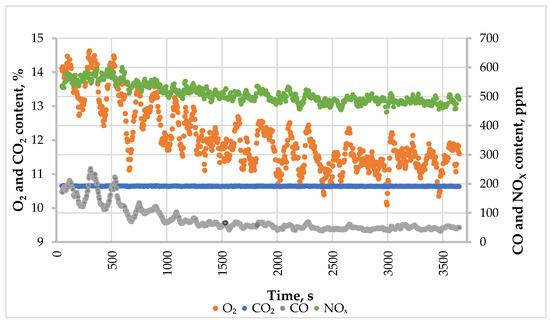
Figure 4.
Chemical composition of flue gases during the combustion of the reference pellet.
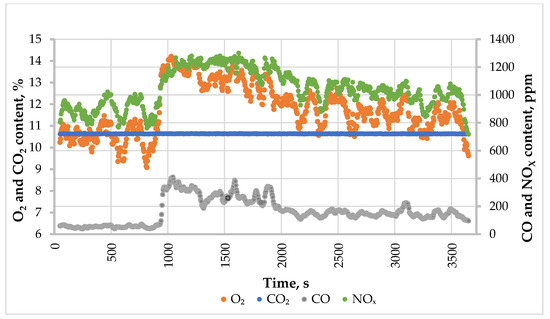
Figure 5.
Chemical composition of flue gases during the combustion of wood-based waste pellets.
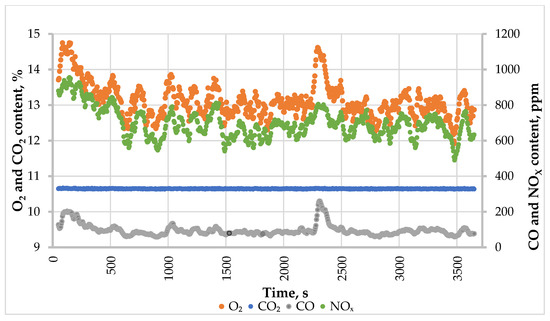
Figure 6.
Chemical composition of flue gases during the combustion of wood-based waste pellets with additive Ad1.
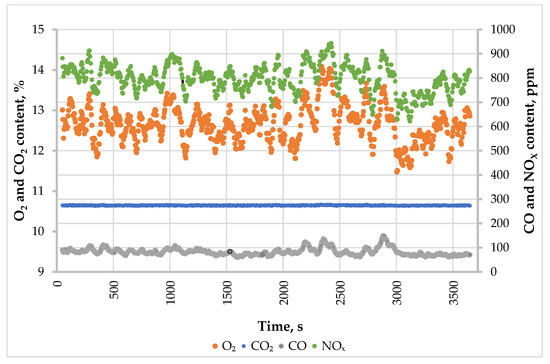
Figure 7.
Chemical composition of flue gases during the combustion of wood-based waste pellets with additive Ad2.
Based on Figure 4, large fluctuations in O2 content in the exhaust gas were observed. At the beginning of the measurements, there were also fluctuations in the CO content, which later stabilized and did not exceed 100 ppm. The NOX content remained at a similar level throughout the duration of the measurements.
As can be seen in Figure 5, a sudden increase in the content of O2, CO, and NOX was observed. However, in the case of carbon monoxide, fluctuations during the measurements stabilized, which did not occur in the case of O2 and NOX.
Considering the data contained in Figure 6, large fluctuations in O2 and NOX content were found, while carbon monoxide content was characterized by lower instability.
During the combustion of waste pellets from furniture boards with the addition of a catalyst with water, there were significant fluctuations in the content of O2 and NOX. However, the carbon monoxide content remained at a similar level.
Based on the graphs above, it can be seen that the level of carbon dioxide in each case was more or less constant at about 10.6%. In the combustion process, the amount of carbon monoxide should decrease with the increase in the oxygen content, while the NOX content should decrease with the decrease in O2, so that the reduction in the content of nitrogen oxides causes an increase in the concentration of carbon monoxide. In each of the above figures, it can be observed that the described dependencies were not always met. This is due to the automatics of the boiler. Combustion was not carried out in manual mode, so the fuel doses were not the same; moreover, the boiler is equipped with a lambda probe. This means that when the carbon monoxide concentration increases, the boiler tries to adjust the fan speed to increase the oxygen content. Therefore, when the amount of carbon monoxide decreases, the fan works less, delivering lower doses of O2.
Figure 8 presents a summary of the average CO content in the exhaust gases from the combustion of each fuel, and Figure 9 shows the average NOX content.
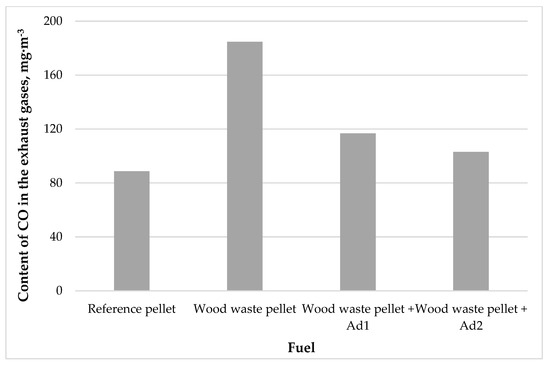
Figure 8.
Carbon monoxide content in the exhaust gases during the combustion of fuels.
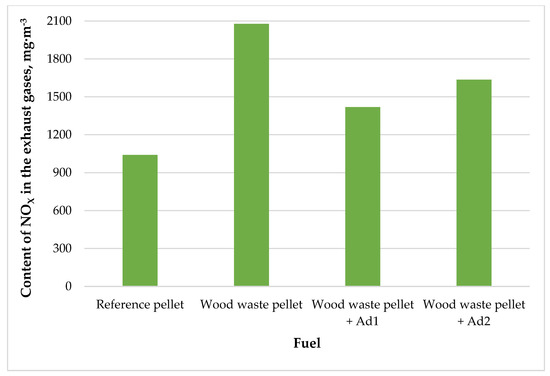
Figure 9.
Nitrogen oxide content in the exhaust gases during the combustion of fuels.
The results of CO and NOX emission measurements were measured in ppm, then converted to mg·m−3 and standardized to 10% oxygen content in the flue gas.
Fuel from wood waste generated significantly higher CO emissions than the reference fuel, but the catalytic additive brought its results closer to those of the reference fuel. The reduction in carbon monoxide emissions is not only important for the safety of the service (given the threat of CO poisoning) but also affects the efficiency of the boiler. Underburned CO increases the loss of incomplete combustion. During the combustion of pellets from plate waste without catalytic additives, the concentration of carbon monoxide was 185 mg·m−3 and was more than twice as high as the concentration seen during the combustion of the reference pellet (89 mg·m−3). The catalytic additives’ application reduced the carbon monoxide emission, and the decrease was 36% for Ad1 and 44% for Ad2.
The lowest concentration of nitrogen oxides was recorded during the combustion of the reference pellet, and it was about 1040 mg·m−3. Considering the pellets from board waste, this value was about 2 times higher. The use of the DESONOX catalytic additive reduced the NOX emission value. Ad1 reduced nitrogen oxide emissions by 31% and Ad2 by 21%.
4. Discussion
Among all the fuels used for the tests, pellets from wood-based waste without any additives stood out with the highest average content of both NOX and CO. The increased NOX emissions during the combustion of pellets from the dust of furniture boards may be caused by a high content of urea adhesives. The adhesive particles release nitrogen compounds into the exhaust gas during combustion. This is mainly due to the nitrogen cycle of NOX formation in low-capacity boilers [30].
In the case of carbon monoxide, it was possible to observe a significant reduction in the content of the exhaust gas component after adding catalysts. The lowest value of CO concentration among the fuels made for the test was distinguished by wood-based waste pellets, which were sprayed with a mixture of catalyst and water (with a reduction in emission of 44% compared to pellets from waste without a catalytic additive). The addition of a catalyst to pellets made of dust from chipboard and MDF board waste led to a slightly higher value, while in both cases, the addition of the catalyst did not allow a reduction in the value to the level of the reference pellet. This may be due to the fact that the catalyst in the form of a liquid suspension penetrated the pellet, which allowed it to be evenly distributed in the sample mat. The pellet with a dry layer of catalytic substance was covered only from the outside. It is known that a more efficient combustion process occurs in the case of better mixing and availability of the oxidant with the fuel particle. The exact mechanism applies to the contact of the catalytic substance particle with the fuel and the oxidant. [31].
The addition of a catalyst allowed a reduction in the emission of nitrogen oxides during the thermal conversion of pellets from wood-based waste. The lowest level of concentration in this case among the fuels produced was achieved with a pellet made of dust from wood-based waste mixed with DESONOX (with a reduction in emissions of 31% compared to a pellet produced from waste without catalytic additives).
Discussions on the safety of waste incineration should also take into account the possible production of other pollutants such as dioxins or furans. Their emission, however, does not depend on the catalytic substance, but rather on the organization of combustion, in particular on the combustion temperature. The use of both catalysts and high-temperature combustion seems to be optimal for safe combustion technology.
5. Conclusions
Through the conducted tests, it was observed that both methods of dosing the catalytic additive resulted in a reduction in the content of undesirable substances during combustion. Spraying pellets with a mixture of catalyst and water brought better results in lowering carbon monoxide content, compared to mixing DESONOX with dust from wood-based waste, while it contributed to achieving slightly worse results when reducing the concentration of nitrogen oxides. Considering the above information, it can be concluded that the method by which the catalyst was sprayed onto the pellets is less efficient. This method of mixing for the production of pellets is more cumbersome and time-consuming, and additionally requires the use of water. Due to the fact that the addition of a small dose of the catalyst caused a significant reduction in the exhaust gas concentration, future tests may be extended to check the level of reduction by using a higher dose of the catalytic additive, which would also allow the determination of the amount of catalyst.
The commercial application of catalytic additives to wood-based waste would bring about several benefits in various aspects. Considering economic considerations, it would allow Poland to remain high in both European and world rankings. This would result in significant financial savings for the plants, which would not have to incur disposal costs and could heat the plants with post-production residues. This process would be an alternative to other bio-waste disposal processes, such as torrefaction [32]. Reducing the content of hazardous compounds released during combustion would improve air quality and minimize the negative influence of chemical compounds on the natural environment and people. As for the technological aspect, people interested in the solution might want to create specially dedicated installations or devices for mixing fuels with a catalyst and burn them directly. Ultimately, this could result in the relaxation of legal regulations or enrich them by mentioning the mixture of fuels with a catalytic additive. The conducted research shows that catalytic additives are an important technology that make the levels of greenhouse gas emissions produced from combustion of post-production waste similar to those produced from pure pellets or other forms of biomass.
Author Contributions
Conceptualization, P.K. and K.B.; methodology, B.G., P.K. and K.B.; software, B.G. and K.B.; validation, P.K. and B.G.; formal analysis, K.B. and P.K.; investigation, K.B., P.K. and B.G.; resources, B.G. and P.K.; data curation, P.K. and K.B.; writing—original draft preparation, K.B., P.W., B.G., B.K. and P.B.; writing—review and editing, B.G., B.K., P.W., P.K., P.B., J.C. and J.K.; visualization, K.B., B.G., B.K. and P.W.; supervision, B.G., P.K. and P.B. All authors have read and agreed to the published version of the manuscript.
Funding
This research received no external funding.
Data Availability Statement
The data presented in this study are available on request from the corresponding author.
Conflicts of Interest
The authors declare no conflict of interest.
References
- Waheed, R.; Sarwar, S.; Wei, C. The survey of economic growth, energy consumption and carbon emission. Energy Rep. 2019, 5, 1103–1115. [Google Scholar] [CrossRef]
- Roni, M.S.; Chowdhury, S.; Mamun, S.; Marufuzzaman, M.; Lein, W.; Johnson, S. Biomass co-firing technology with policies, challenges, and opportunities: A global review. Renew. Sustain. Energy Rev. 2017, 78, 1089–1101. [Google Scholar] [CrossRef]
- Uddin, M.N.; Techato, K.; Taweekun, J.; Rahman, M.M.; Rasul, M.G.; Mahlia, T.M.I.; Ashrafur, S.M. An Overview of Recent Developments in Biomass Pyrolysis Technologies. Energies 2018, 11, 3115. [Google Scholar] [CrossRef]
- Leskinien, P.; Cardellini, G.; Gonzalez-Garcia, S.; Hurmekoski, E.; Sathre, R.; Seppala, J.; Smyth, C.; Stern, T.; Verkerk, P. Substitution Effects of Wood-Based Products in Climate Change Mitigatiom; From Science to Policy 7; EFI: Joensuu, Finland, 2018; ISBN 978-952-5980-69-1. [Google Scholar]
- Kobuszynska, M. Report: Forestry and Wood Products in Poland, Global Agricultural Information Network. 2017. Available online: https://apps.fas.usda.gov/newgainapi/api/report/downloadreportbyfilename?filename=The%20Forestry%20and%20Wood%20Products%20in%20Poland_Warsaw_Poland_3-23-2017.pdf (accessed on 15 December 2022).
- Parikka, M. Global biomass fuel resources. Biomass Bioenergy 2004, 27, 613–620. [Google Scholar] [CrossRef]
- Kajda-Szcześniak, M. Evaluation of the basic properties of the wood waste and wood based wastes. Arch. Waste Manag. Environ. Prot. 2013, 15, 1–10. [Google Scholar]
- Carvalho, L.; Magalhães, F.; Ferra, J. Formaldehyde emissions from wood-based panels-Testing methods and industrial perspectives. In Formaldehyde: Chemistry, Applications and Role in Polymerization; Nova Science Publishers, Inc.: Hauppauge, NY, USA, 2012; pp. 1–45. [Google Scholar]
- Wasilewski, R.; Hrycko, P. Efekty energetyczno-emisyjne spalania odpadów z przeróbki płyt drewnopochodnych w kotle małej mocy. Arch. Gospod. Odpad. I Ochr. Sr. 2010, 12, 27–34. [Google Scholar]
- De Ligne, L.; Van Acker, J.; Baetens, J.M.; Omar, S.; De Baets, B.; Thygesen, L.G.; Van den Bulcke, J.; Thybring, E.E. Moisture Dynamics of Wood-Based Panels and Wood Fibre Insulation Materials. Front. Plant Sci 2022, 13, 951175. [Google Scholar] [CrossRef] [PubMed]
- Council Directive 2010/75/EC on Industrial Emissions (Integrated Pollution Prevention and Control). Official Journal of the European Communities. 2010. Available online: https://eur-lex.europa.eu/LexUriServ/LexUriServ.do?uri=OJ:L:2010:334:0017:0119:en:PDF (accessed on 15 December 2022).
- Wasielewski, R. The use of engineered wood wastes for energy production. Arch. Waste Manag. Environ. Prot. 2019, 21, 1–8. [Google Scholar]
- Igliński, B.; Cichosz, M.; Skrzatek, M.; Buczkowski, R. Technical potential of waste biomass for energy in Poland. Eng. Prot. Environ. 2018, 22, 109–118. [Google Scholar] [CrossRef]
- Cesprini, E.; Resente, G.; Causin, V.; Urso, T.; Cavalli, R.; Zanetti, M. Energy recovery of glued wood waste–A review. Fuel 2020, 262, 116520. [Google Scholar] [CrossRef]
- Kraszkiewicz, A.; Przywara, A.; Parafiniuk, S. Emission of Nitric Oxide during the Combustion of Various Forms of Solid Biofuels in a Low-Power Heating Device. Energies 2022, 15, 5960. [Google Scholar] [CrossRef]
- Kułażyński, M.; Świątek, Ł.; Pstrowska, K. Katalityczna redukcja tlenków azotu ze spalania biomasowych kotłów małej mocy. Logistyka 2015, Nr 5, 289–294. [Google Scholar]
- Radsak, D. Redukcja emisj tlenków azotu w kotłach energetycznych jako konieczność spełniania europejskich standardów emisyjnych. Electr. Eng. 2017, 90, 333–345. [Google Scholar] [CrossRef]
- Hakawati, R.; Smyth, B.M.; McCullough, G.; De Rosa, F.; Rooney, D. What is the most energy efficient route for biogas utilization: Heat, electricity or transport? Appl. Energy 2017, 206, 1076–1087. [Google Scholar] [CrossRef]
- Panepinto, D.; Tedesco, V.; Brizio, E.; Genon, G. Environmental performances and energy efficiency for MSW gasification treatment. Waste Biomass Valorization 2015, 6, 123–135. [Google Scholar] [CrossRef]
- Kordylewski, W. Spalanie i Paliwa; Oficyna Wydawnicza Politechniki Wrocławskiej: Wrocław, Polska, 2008; pp. 10–470. ISBN 978-83-7493-378-0. [Google Scholar]
- Marcewicz-Kuba, A. Effect of the synthetic zeolite modification on its physicochemical and catalytic properties in the preparation of the catalysts effectively removing sulphur dioxide from exhaust gases. Pol. J. Chem. Technol. 2016, 18, 40–45. [Google Scholar] [CrossRef]
- Tic, W.J. System poprawy efektywności energetycznej i ekologicznej spalnia paliw stałych. Chemik 2014, 68, 850–855. [Google Scholar]
- Gaze, B.; Romański, L.; Kułażyński, M. Koncepcja wykorzystania mocznika do ograniczenia emisji NOx w kotłach małej mocy. Przemysł Chem. 2020, 99, 569–573. [Google Scholar] [CrossRef]
- Standard PN-EN ISO 18134-1; Solid Biofuels—Determination of Moisture Content—Oven Dry Method—Part 1: Total Moisture—Reference Method. Polish Committee for Standardization: Warsaw, Poland, 2016. Available online: https://standards.globalspec.com/std/9951652/iso-18134-1 (accessed on 24 January 2022).
- Standard PN-EN ISO 18125:2017-07; Solid Biofuels—Determination of Calorific Value. Polish Committee for Standardization: Warsaw, Poland, 2017. Available online: https://standards.globalspec.com/std/9972508/iso-18125 (accessed on 24 January 2022).
- Standard PN-EN ISO 18122:2016-01; Solid Biofuels—Determination of Ash Content. Polish Committee for Standardization: Warsaw, Poland, 2016. Available online: https://standards.globalspec.com/std/2051854/iso-18122 (accessed on 24 January 2022).
- Standard PN-EN ISO 18123:2016-01; Solid Biofuels—Determination of the Content of Volatile Matter. Polish Committee for Standardization: Warsaw, Poland, 2016. Available online: https://standards.globalspec.com/std/2051856/iso-18123 (accessed on 24 January 2022).
- Standard PN-EN ISO 16948:2015-07; Solid Biofuels—Determination of Total Content of Carbon, Hydrogen and Nitrogen. Polish Committee for Standardization: Warsaw, Poland, 2015. Available online: https://standards.globalspec.com/std/2048180/iso-16948 (accessed on 24 January 2022).
- Gaze, B.; Knutel, B.; Jajczyk, M.; Wacławek, A.; Bukowski, P.; Dębowski, M. Analysis of the use of catalytic additives for combustion with wood pellets in a low-power boiler. Rynek Energii 2021, 4, 93–98. [Google Scholar]
- Gaze, B. Określenie dominującego mechanizmu powstawania NOX w kotłach małej mocy zasilanych biomasą. Przemysł Chem. 2020, 1, 70–75. [Google Scholar] [CrossRef]
- Böhler, L.; Görtler, G.; Krail, J.; Kozek, M. Carbon monoxide emission models for small-scale biomass combustion of wooden pellets. Appl. Energy 2019, 254, 113668. [Google Scholar] [CrossRef]
- Piersa, P.; Szufa, S.; Czerwińska, J.; Ünyay, H.; Adrian, Ł.; Wielgosinski, G.; Obraniak, A.; Lewandowska, W.; Marczak-Grzesik, M.; Dzikuć, M.; et al. Pine Wood and Sewage Sludge Torrefaction Process for Production Renewable Solid Biofuels and Biochar as Carbon Carrier for Fertilizers. Energies 2021, 14, 8176. [Google Scholar] [CrossRef]
Disclaimer/Publisher’s Note: The statements, opinions and data contained in all publications are solely those of the individual author(s) and contributor(s) and not of MDPI and/or the editor(s). MDPI and/or the editor(s) disclaim responsibility for any injury to people or property resulting from any ideas, methods, instructions or products referred to in the content. |
© 2023 by the authors. Licensee MDPI, Basel, Switzerland. This article is an open access article distributed under the terms and conditions of the Creative Commons Attribution (CC BY) license (https://creativecommons.org/licenses/by/4.0/).